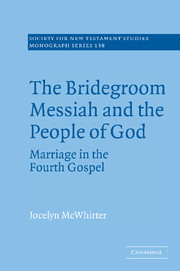Book contents
- Frontmatter
- Contents
- Acknowledgments
- List of abbreviations
- 1 Allusions to biblical texts about marriage
- 2 Echoes of Scripture, representative figures, and messianic exegesis
- 3 The revelation of the bridegroom-Messiah: allusions to Jeremiah 33:10–11 and Genesis 29:1–20
- 4 The glorification of the bridegroom-Messiah: allusions to Song 1:12 and Song 3:1–4
- 5 The bridegroom-Messiah of Psalm 45 in the Song of Songs, Jeremiah 33:10–11, and Genesis 29:1–20
- 6 Hearing the echoes
- 7 Conclusion
- Bibliography
- Scripture index
- Index of ancient commentators
- Index of modern commentators
5 - The bridegroom-Messiah of Psalm 45 in the Song of Songs, Jeremiah 33:10–11, and Genesis 29:1–20
Published online by Cambridge University Press: 22 September 2009
- Frontmatter
- Contents
- Acknowledgments
- List of abbreviations
- 1 Allusions to biblical texts about marriage
- 2 Echoes of Scripture, representative figures, and messianic exegesis
- 3 The revelation of the bridegroom-Messiah: allusions to Jeremiah 33:10–11 and Genesis 29:1–20
- 4 The glorification of the bridegroom-Messiah: allusions to Song 1:12 and Song 3:1–4
- 5 The bridegroom-Messiah of Psalm 45 in the Song of Songs, Jeremiah 33:10–11, and Genesis 29:1–20
- 6 Hearing the echoes
- 7 Conclusion
- Bibliography
- Scripture index
- Index of ancient commentators
- Index of modern commentators
Summary
Thus far, the evidence supports the probability that John echoes Jer. 33:10–11, Gen. 29:1–20, Song 1:12, and Song 3:1–4. For each proposed allusion, several instances of verbal correspondence are reinforced by significant parallel circumstances. Each is marked by dissonance or rhetorical emphasis (or both). What is more, each helps to illustrate the revelation and glorification of the Messiah. In John 3:22–30, Jeremiah's prophecy helps to portray Jesus as the bridegroom-Messiah whose voice, heard by his friend John the Baptist, causes him to rejoice. John 4:4–42 echoes Jacob's betrothal narrative to depict Jesus as the bridegroom-Messiah who offers eternal life and, together with the Samaritan woman, establishes a family of faith. In John 12:1–8, an allusion to the Song's reclining king helps to foreshadow the impending death of Jesus, the bridegroom-Messiah. Finally, John 20:1–18 echoes the search of the Song's bride to describe Mary Magdalene's recognition of Jesus, the risen and ascending Lord.
As yet, however, it is not at all clear why the Fourth Evangelist echoes these particular passages. What attracts him to a marriage metaphor? Why does he liken Jesus to Jeremiah's bridegroom? Why does he allude to a betrothal narrative and an erotic poem? In short, how were Jer. 33:10–11, Gen. 29:1–20, Song 1:12, and Song 3:1–4 prominent for the Fourth Gospel's implied author?
I think the answers to these questions lie in a messianic interpretation of the evoked texts.
- Type
- Chapter
- Information
- The Bridegroom Messiah and the People of GodMarriage in the Fourth Gospel, pp. 106 - 122Publisher: Cambridge University PressPrint publication year: 2006



